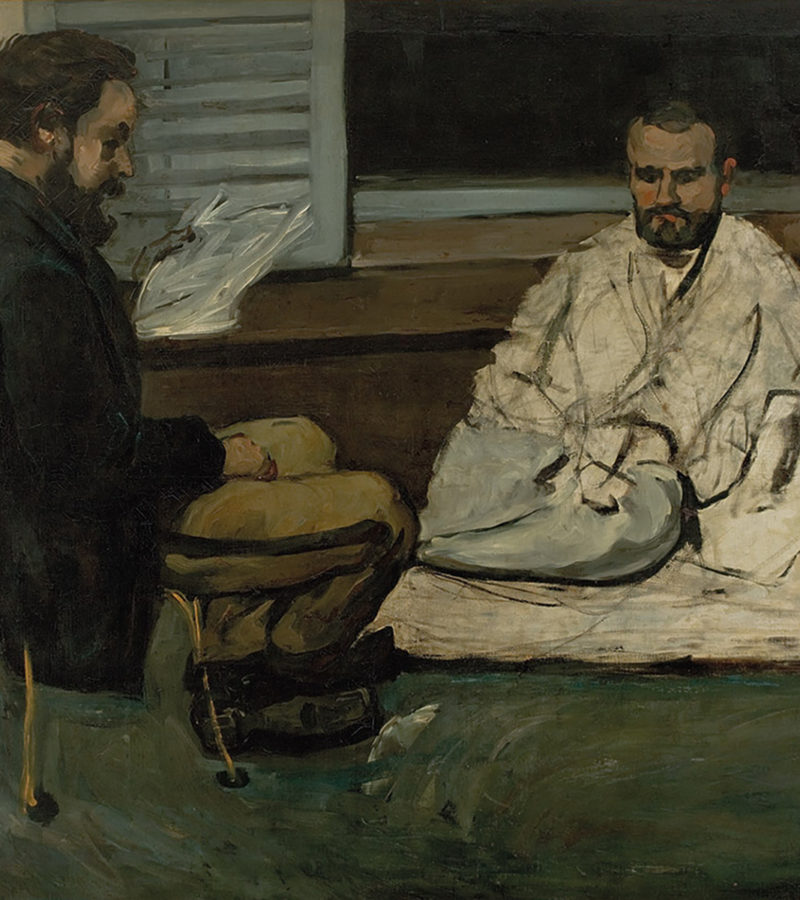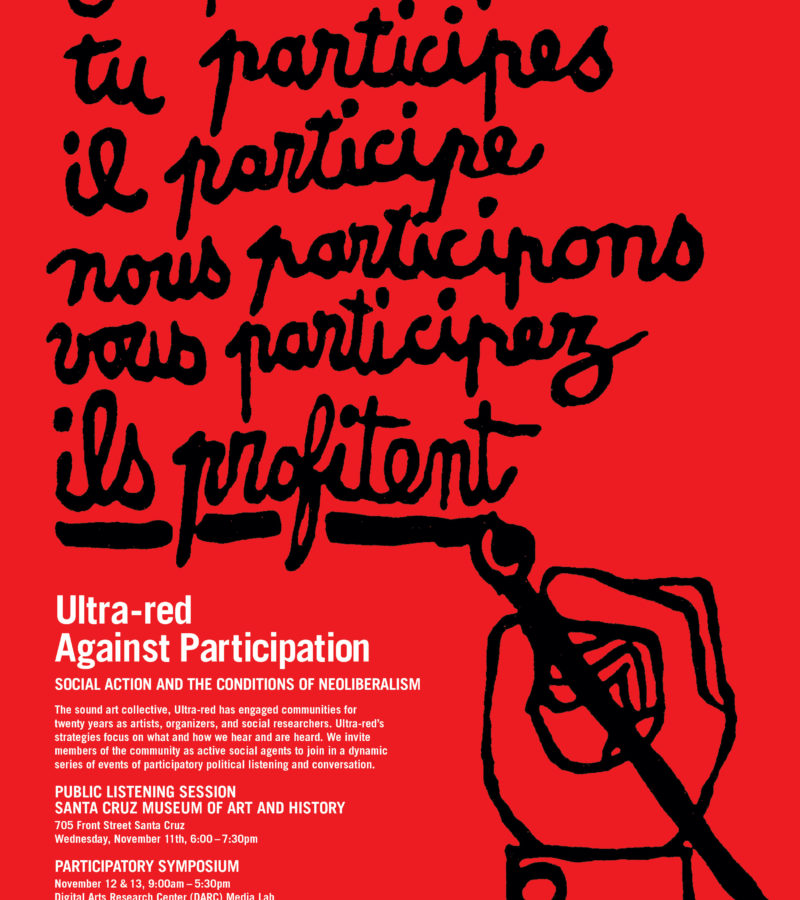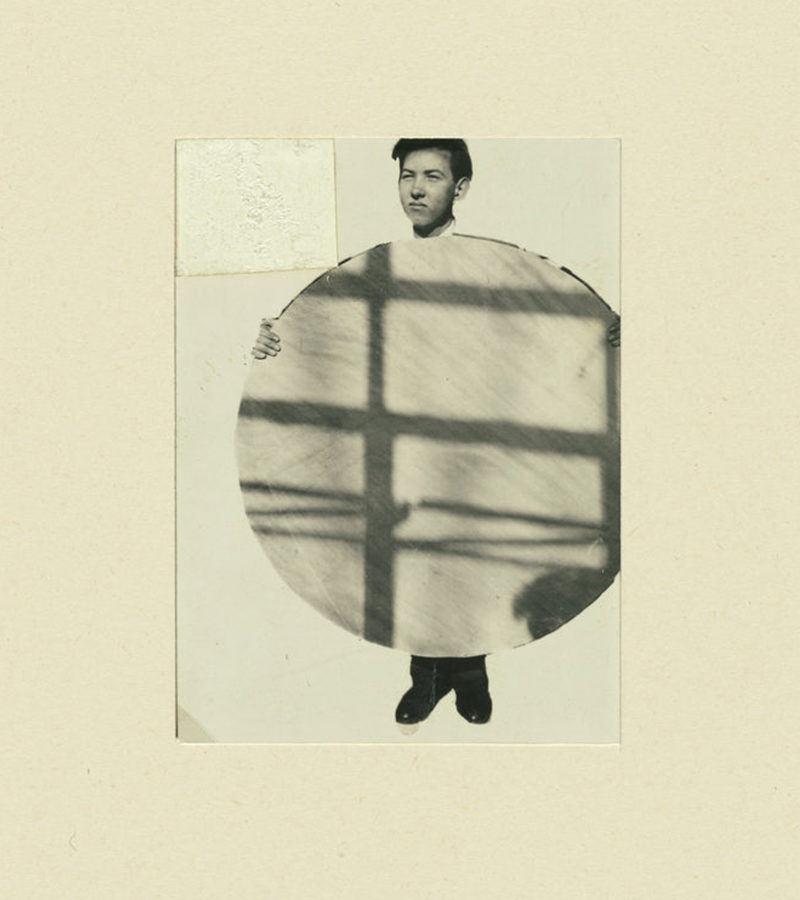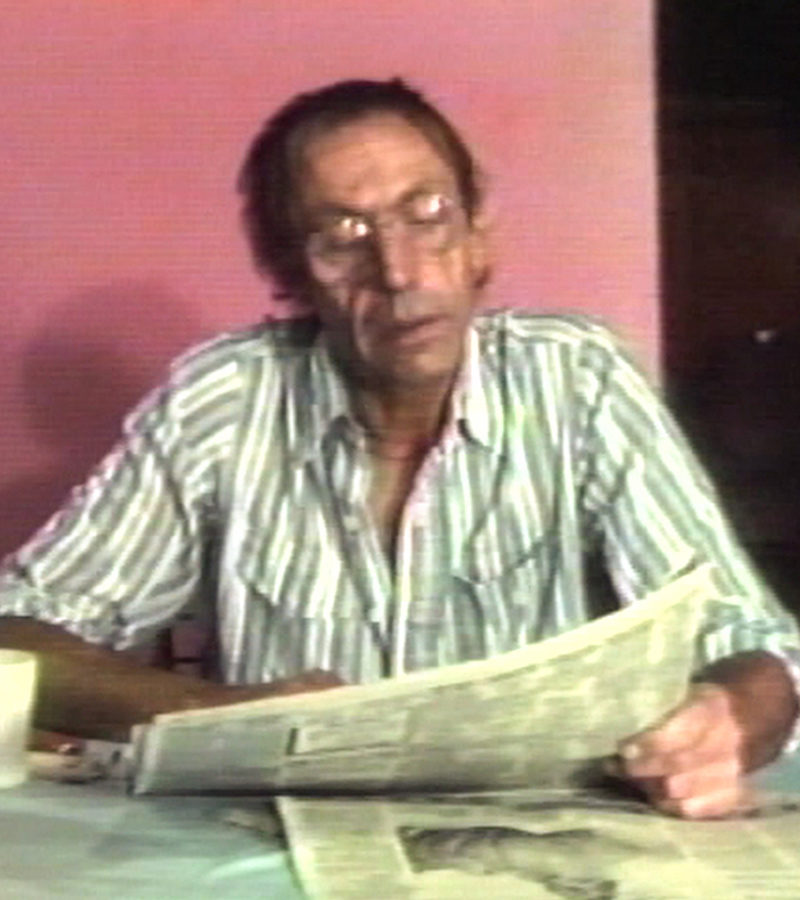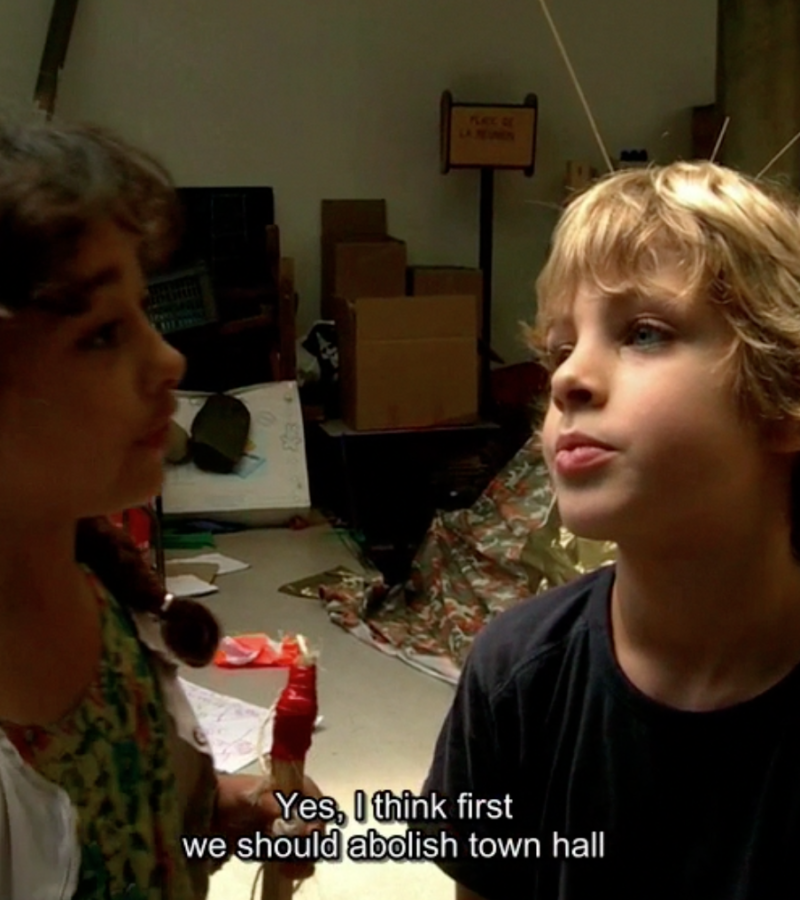The painting entitled Capoeira, by the Brazilian artist Maria Auxiliadora, first strikes us for its dynamic structure. Its characters, vertically displayed, occupy almost the totality of the canvas, leaving the top to simple brick houses and trees that seem to bend to fit the limits of the frame. The characters’ costumes and the surrounding vegetation seem to have been delicately embroidered, giving the overall work the appearance of something precious. Beautiful colours give spirit to the painting, and the artist pays special attention to contours, using lines and dots as a strategy for animating objects, plants and people.
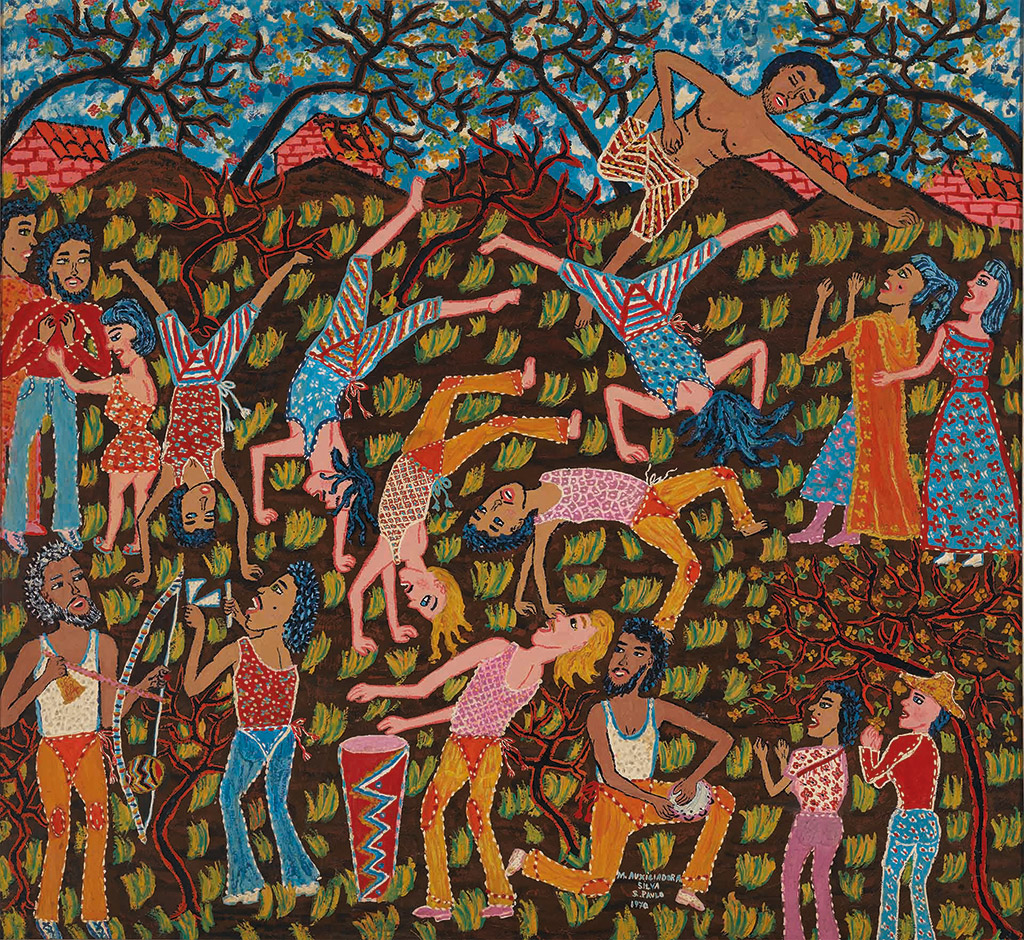
But capoeira is not only about potency, it is also about grace, rhythm, timing. When we look at this prominent figure in the painting, his eyes closed and his body raised against the sky, we might also think of the aspect of capoeira known as Mandinga. Difficult to translate, this innate quality is a source of power, knowledge and protection, manifested by the best practitioners. Here, the man’s closed eyes seem to access something situated inwards, while his body outwardly displays ginga, perhaps translated as ‘swag’. Meanwhile his mouth, singing with the rest of the group, shows that he is entirely connected to what happens in the circle.
In a 2005 documentary made by Lázaro Faria, masters of capoeira use their own words to try to explain what Mandinga can mean:
All of these definitions are about a non-normative kind of wisdom that is rooted in the body, dependent on the soul, language defiant. This kind of knowledge has not only been rejected in Western and art history, but by Western traditions in general. Maria Auxiliadora (1935–1974) was a master at translating experiences that had been made invisible or that were, and in some cases still are, unknown and unrecognisable to the so-called ‘cultivated’ eye.
While today masters of the art of Capoeira, such as Bimba and Pastinha, are widely celebrated, and in 2014 Capoeira was added to the United Nations heritage list. Capoeira is originally a kind of fight, that was first disguised by enslaved people as a dance. After abolition, it was criminalised in Brazil. The experience depicted in Auxiliadora’s painting is that of people living in the outskirts of São Paulo in the 1960s and 1970s, some involved with Afro-Brazilian religions, such as the Candomblé with its orisha (minor deities), and Umbanda, a syncretic blend of Catholicism, Spiritism, Indigenous American and African traditions. These kinds of manifestations were historically persecuted, their practitioners harassed by the police. Sacred objects were confiscated and the practice in general stigmatised as well as criminalised. It is for this reason that the representation of the connection of these individuals with their spiritual life – their contact with their inner strengths – is of the uttermost importance.
Among Auxiliadora’s works are interesting rural scenes that attest to the artist’s family origins. At a very young age she migrated with her parents and brothers from the agrarian Minas Gerais to the more urban and industrial São Paulo. Her representations of adult night classes are a reminder of the difficulties she faced in pursuing an education. Prosaic scenes of working-class family luncheons sit alongside joyous windows into African Brazilian everyday life. Auxiliadora depicted her own existence, fantasies and fears, dealing with the emancipation of a working woman, romance, erotism, as well as the experience of severe illness at an early age. She died at the age of 39 after having painted her own wake.
In several of Maria Auxiliadora’s works, the artist applies strands of hair to the canvas, often her own, indicating as a motivation the proper characterisation of her Black figures. In doing this she not only she achieved what she believed to be a trustworthy representation of the group to which she belonged, but also inserted indicators of alterity, recognisable to her buyers – mostly white. Stuart Hall asserts that the term ‘Black’ designates a culturally and politically constructed category, adopted as an organising denomination applicable to groups and individuals with different histories, traditions, and identities to refer to the common experience of diaspora and racism. For Hall, this delimitation in fact opens spaces for the challenge, resistance, and transformation of dominant regimes of representation, suggesting the term as a substitute for ‘the Other’. Auxiliadora manipulates elements of this Black aesthetic as manifested in the body, especially in the colour of skin and hair, underlining ethnic identity data while reframing them. The incorporation of hair in her paintings emphasises the first person of the author and allows us to imagine a form of power in the work, enhanced by an energy that contains within it a kind of reclamation of ‘magical thinking’.
During the 1960s Auxiliadora primarily sold her works at a street art fair until Mário Schenberg, an art critic, started buying her works in the ’70s. Schenberg introduced her to marchands, collectors and also to Alan Fischer, the American consul at the time, who organised her first exhibition at the United States Information Services Gallery in São Paulo. There she sold all the paintings shown. Although her work was acquired by important museums, in the decades after her death it was rapidly forgotten. It wasn’t until an important exhibition at the Museu de Arte de São Paulo in 2018 that her attention was brought back to the attention of researchers, galleries and cultural institutions.
In a in a photograph included in the MASP exhibition, the artist is shown standing next to Fischer, her hair shaped in a classic Black style crowning her elegant height, in tune with the affirmation of identity derived from the American mantra ‘black is beautiful’. We can assume the artist’s familiarity with the meaning of this affirmation came from various sources, for one her brother João Cândido’s role, in 1957, as one of the founders of the politically and culturally important samba school Sociedade Esportiva Recreativa Beneficente Unidos do Parque Peruche. Like his sister’s, João’s work as a painter represents scenes of carnival, another terrain of forbidden and marginalised cultural expression. To be involved with samba in Brazil at the time was dangerous, and among the many stories of police violence against samba musicians, some end in death.
It is important to note the proximity of Maria Auxiliadora with the group of Black artists from the city of Embu, who worked with dance and theatre as well as visual arts. It was there that she met the sculptor Claudionor Assis Dias, a pioneer in the group, and Solano Trindade – poet, theatre writer, actor, filmmaker, painter and key figure in Brazilian culture. Auxiliadora also spent time with Solano’s daughter Raquel Trindade, an artist who married another of Auxiladora’s brothers Vicente Paulo da Silva. Several of Auxiliadora’s works depicting street cultural celebrations and manifestations can be seen as be a testament to the popular cultural activities promoted by that circle and involving their city’s community.
In Wedding Night (1974), for example – a painting that renders the encounter of newlyweds in the privacy of their bedroom – sexualised bodies are contextualised in the form of the couple’s intimacy. Here, Auxiliadora unifies romance and pleasure, suggesting a subjectivity oppositional to the narrow sense in which Black bodies are often fetishistically polarised as either asexual or hypersexual. Kerry James Marshall also refers to precisely this issue, representing Black people in romantic and intimate situations while seeking to transcend the primary meaning that images of sentiment typically convey. By calling attention to certain conventions, the artist questions the stigma carried by popular culture, and the means by which it produces emotion. Using an almost pitch black to characterise the skin of his figures, Marshall points to the negative charge historically associated with Blackness. In the ‘Black Romantic’ series, couples walk along a seashore or watch the sun setting in representations that touch the boundaries of kitsch, underlining Black existence and Black relationships as invisible as Blackness itself in the history of canonical art. His ‘Vignette’ series similarly invokes memories that history made impossible. Couples lying on grass or playing hide and seek create scenes of sterile nostalgia in grisaille.
As the comparison with Kerry James Marshall illustrates, Maria Auxiliadora was far more interesting and challenging an artist than accounts restricting her to the ‘naïve’ denomination would imply. Auxiliadora may not have been fully conscious about her choices, but nor was she ignorant. Maria Auxiliadora was an artist acutely mindful of her time, her culture and the source of her artistic vocabulary. Maria Auxiliadora gives us hope for an art history capable of encompassing the different forms of Mandinga created by Black artists. Many of these artists have found ways of sharing their knowledge and magic with us, proving that it is possible to make much out of what looks like nothing, just as the masters of capoeira teach.
